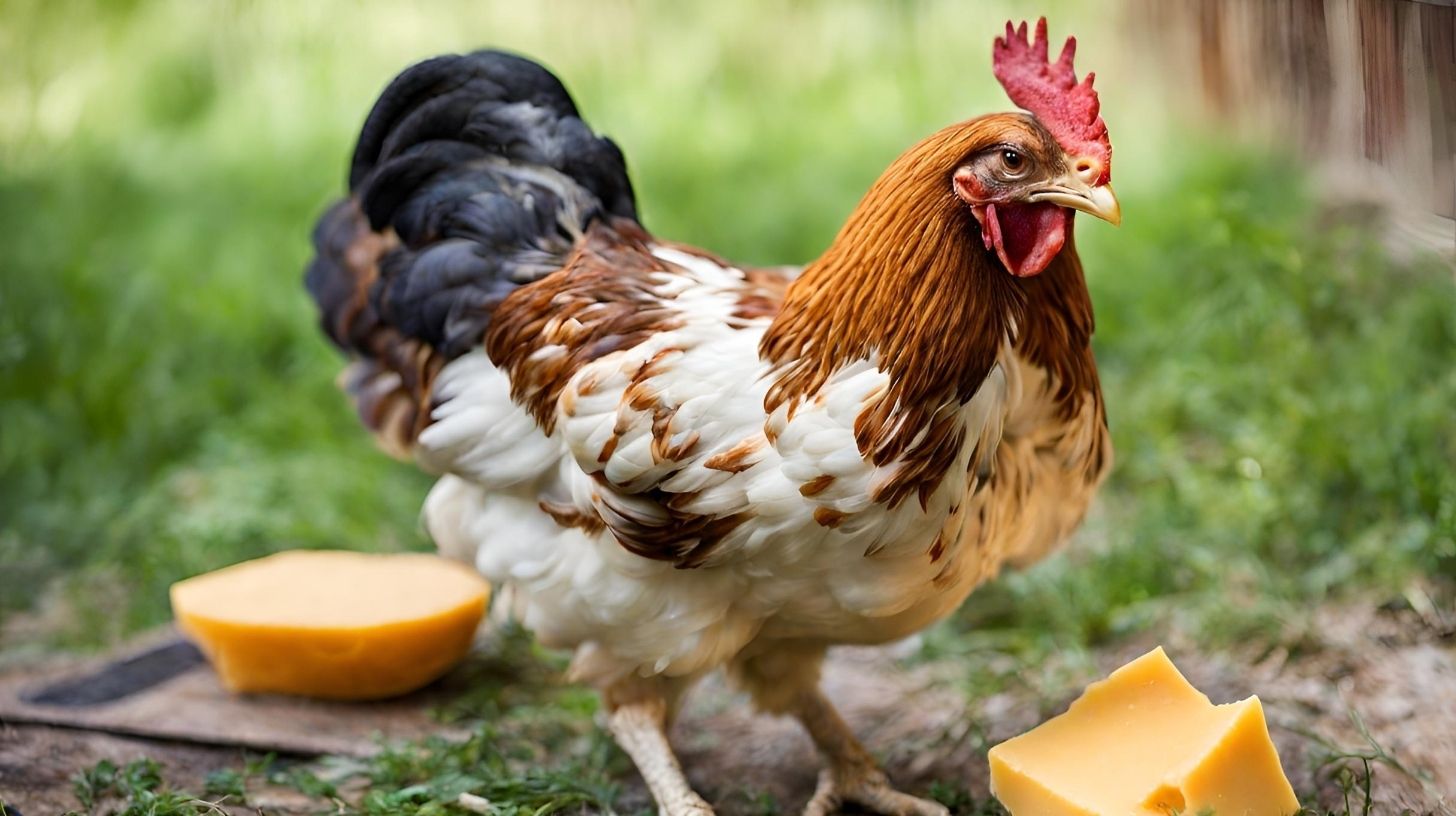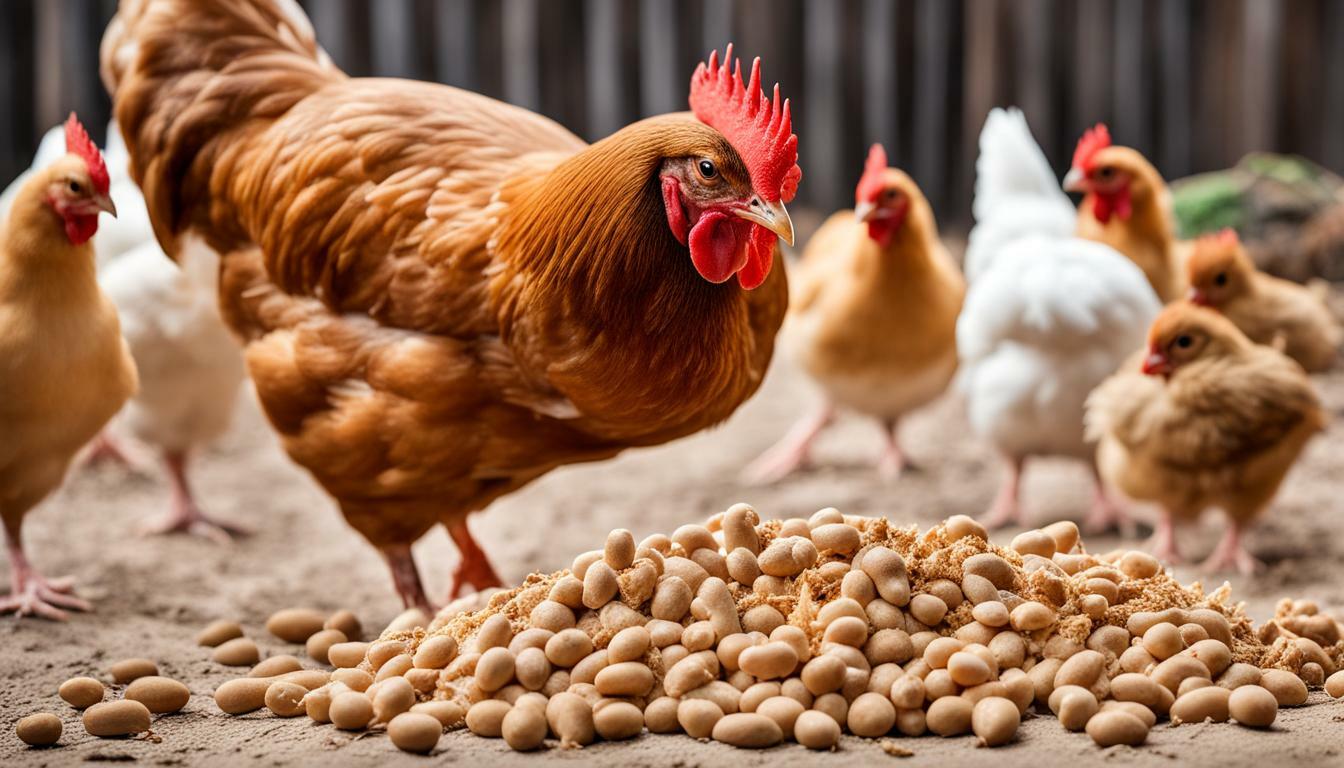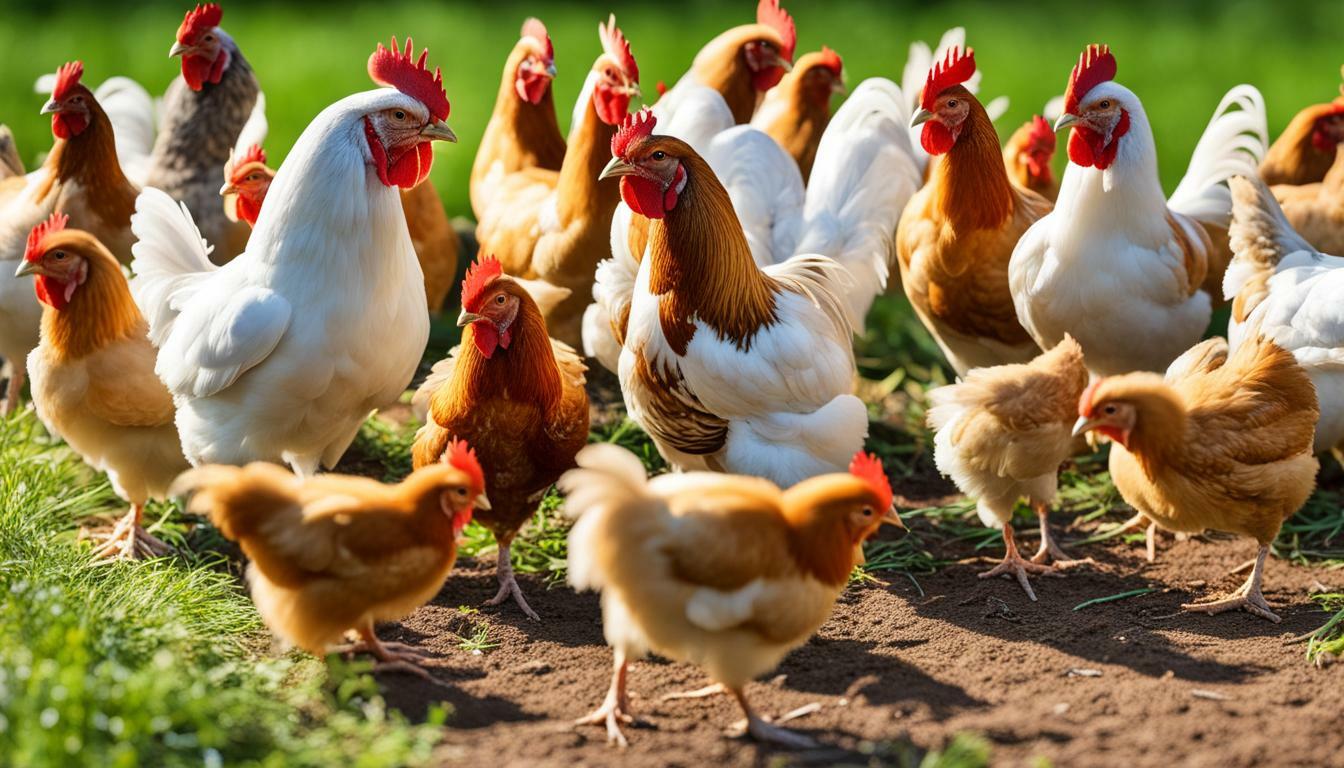Can Chickens Eat Grapes? Key Facts for Owners
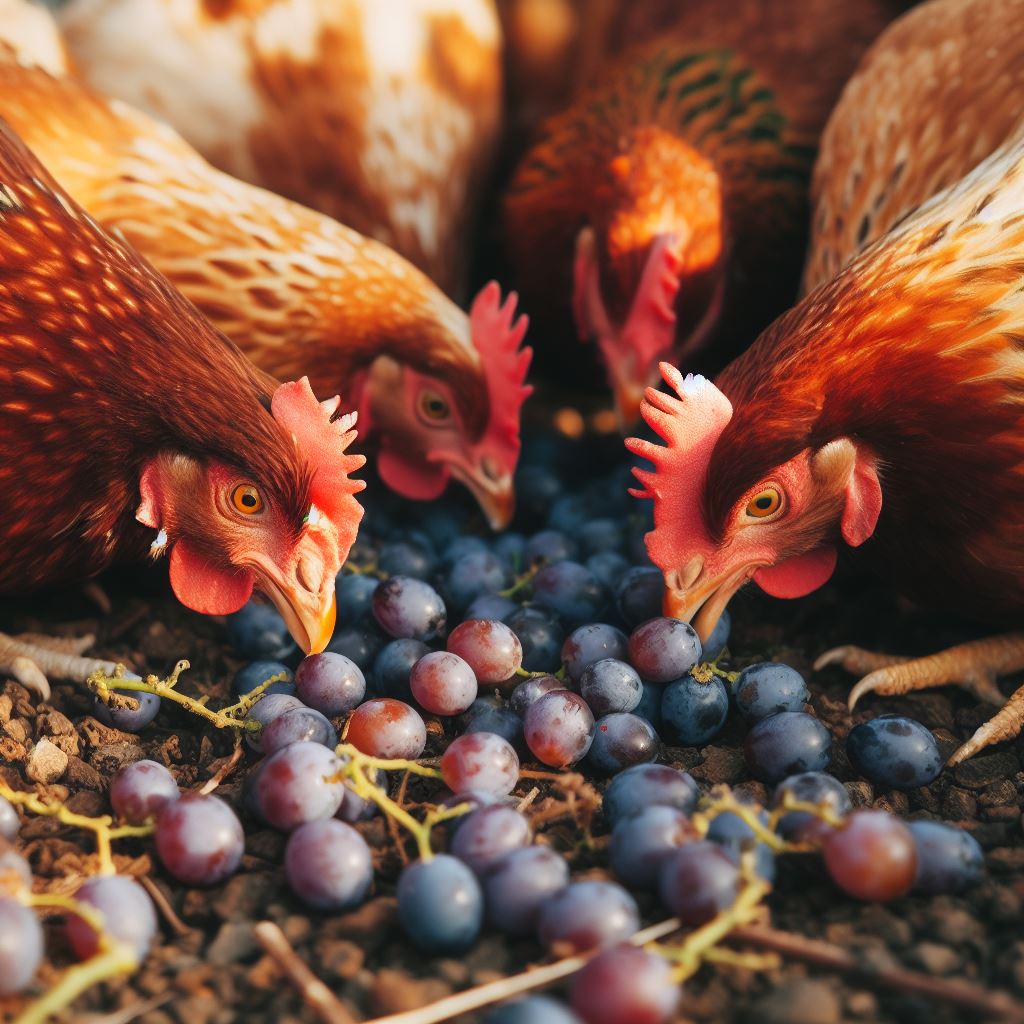
Table of content:
- Are Grapes Safe for Chickens to Eat?
- Feeding Guidelines for Grapes
- Health Concerns with Too Many Grapes
- Are Grape Leaves and Vines Safe for Chickens?
- How Do Grapes Fit Into a Balanced Diet?
- How Many Grapes Can Chickens Eat?
- Ideal Serving Methods for Grapes
- Do’s and Don’ts of Feeding Grapes to Chickens
- FAQs
- Conclusion
Grapes make a refreshing, juicy treat that many backyard chicken owners like to share with their flock. But can chickens eat grapes safely? This comprehensive guide will cover everything you need to know about feeding grapes to chickens.
 Are Grapes Safe for Chickens to Eat?
Are Grapes Safe for Chickens to Eat?
Grapes are non-toxic for chickens and safe to eat. Both red and green grapes make a tasty, nutritious treat. However, chickens should only eat grapes in moderation, due to their high sugar content.
Grapes contain high amounts of natural sugars – 18g per 100g serving. This is a substantial amount compared to other fruits. Too much sugar can cause digestive upsets in chickens and lead to diarrhea.
Overindulging in sugary treats like grapes may also cause unhealthy weight gain and obesity over time. Obese chickens are prone to other health issues like fatty liver disease and egg-laying complications.
As with any new food, grapes should be introduced slowly. Only offer a few grapes per chicken, 2-3 times a week at most. Watch for any signs of loose stool or other adverse reactions.
Some key advantages of feeding grapes to chickens include:
- Nutrition: Grapes provide vitamins C, K, and B6, plus minerals like potassium, copper, and manganese. They also contain antioxidants like resveratrol and flavonoids that support health.
- Treat: Chickens enjoy grapes as a sweet, juicy treat. The change in flavor and texture adds variety to their diet.
- Hydration: The high water content in grapes helps keep chickens hydrated. This is especially helpful in summer.
As long as proper precautions are taken, grapes make a nutritious supplemental food for backyard chickens. Let’s look more in-depth at how to feed grapes safely.
Feeding Guidelines for Grapes
When feeding grapes to chickens, keep these tips in mind:
Choose Seedless Grapes
Seedless grape varieties are best for chickens. Grape seeds are small and somewhat hard – if swallowed whole, they can cause impaction in a chicken’s crop or gizzard.
Impaction occurs when an object like a seed obstructs the digestive tract, making it difficult or impossible to pass food and clear the blockage. This can be life-threatening if not treated promptly.
Seedless grapes help avoid this risk entirely. Popular seedless varieties like Thompson and Concord grapes are good options.
Chop Into Small Pieces
Regardless of the grape type, it’s important to chop into bite-sized pieces before feeding to chickens. Whole grapes pose a major choking hazard for chickens.
Cut each grape into quarters or smaller pieces. You can easily do this with a knife or kitchen shears right before feeding.
Feed in Moderation
Grapes should only make up a small portion of a chicken’s overall diet. Offer just a few grape pieces per bird, 2-3 times weekly at most.
A serving of 3-5 grapes per chicken is reasonable. Larger breeds can handle slightly more; bantams and younger chicks need less. Never let chickens eat grapes freely.
Separate Chickens for Treats
To control portions, consider separating chickens into smaller groups for any treat feeding. Or, feed each chicken individual portions while confined in their coop or a pen.
This prevents bullying or competition over grape treats, ensuring all chickens get an equal share.
Avoid Too Much Sugar
Since grapes are high in sugar, don’t combine them with other sugary foods like watermelon, apples, corn, etc. Too much sugar can cause digestive upset.
Offer grapes as an alternative to other sugary treats to add variety, rather than feeding high-sugar foods daily. Always separate treats from main meals to prevent overeating.
Prevent Obesity
Monitor your chickens’ weight whenever feeding high-calorie treats. Obese chickens are more prone to health problems.
If your chickens become overweight, cut back on grape portions or discontinue use. Promote free-range exercise and feed a balanced diet to maintain a healthy weight.
Introduce Slowly
When offering any new food, including grapes, start slowly. Introduce just a bite or two at first and watch for any adverse reactions.
Increase portion sizes gradually over a week as the chickens adjust. Discontinue use if any chicken shows signs of an allergic reaction or intolerance.
Always Fresh
Feed chickens only fresh, firm grapes. Moldy, wilted, or spoiled grapes could cause illness. Avoid frozen grapes, as these become too hard once thawed.
Wash grapes thoroughly to remove any chemical residues from production. Store any uneaten grapes promptly in the refrigerator and use within 3 days.
 Health Concerns with Too Many Grapes
Health Concerns with Too Many Grapes
While nutritious in moderation, too many grapes can negatively impact a chicken’s health:
Digestive Issues
Excessive sugar and low fiber in grapes may cause loose stool or diarrhea. Yeast infections could also occur. Symptoms may include a foul odor, unusual discharge, or a crusty vent.
Dehydration
Diarrhea leads to dehydration as fluid is lost. Ensure ample fresh water is always available if feeding grapes. Watch for signs of dehydration like pale comb/wattles, lethargy, dry skin, and thick mucus.
Weight Gain
Grapes are high in natural sugar with only trace protein and fat. Too many grapes can contribute to obesity in backyard chickens. Obese chickens are prone to more health problems.
Egg-Binding
Obesity makes egg-binding more likely in hens. This is when a fully-formed egg gets stuck and cannot be laid. It requires prompt veterinary treatment.
Fatty Liver Disease
Excess fat accumulates in chickens’ liver and abdomen due to obesity. Over time, this can lead to liver failure and death.
Crop Impaction
Whole grapes or seeds could get lodged in a chicken’s crop. This may require surgery if the blockage doesn’t clear on its own. Always chop grapes before feeding.
Monitor your flock for any concerning symptoms if offering grapes frequently. Reduce portion sizes or discontinue use if any issues arise.
Are Grape Leaves and Vines Safe for Chickens?
Chickens should not eat other parts of grapevines, including leaves and vines.
Grape leaves contain high amounts of oxalates. Oxalates bind to calcium and can lead to nutritional deficiencies. Grape leaves can also potentially cause kidney damage in chickens if consumed in excess.
Meanwhile, vines contain toxic compounds that can cause illness in chickens. They lack nutritional value and are difficult to digest.
So while grapes make a healthy, nutritious treat, avoid letting chickens access other parts of the grapevine for safety. Restrict treats to just the grapefruits themselves.
How Do Grapes Fit Into a Balanced Diet?
Grapes should not make up a substantial part of your chickens’ diet. They lack key nutrients chickens need daily like protein, fat, and calcium.
Feed grapes sparingly as a supplemental treat alongside a complete feed and fresh greens.
Chickens require the following nutrition in their daily diet:
- 16-20% minimum protein from sources like whole grains, bugs/insects, legumes, sprouted seeds, and produce scraps. This supports growth, development, and egg production.
- 3-5% fat from plant-based sources like seeds, nuts, and healthy oils. Fat provides concentrated energy.
- Calcium from sources like oyster shell and crushed eggshells. Laying hens especially require extra calcium for egg production.
- Grit to aid digestion, obtained from insoluble stones.
A quality complete feed provides balanced nutrition to meet these requirements. Supplement with fresh fruits, veggies, sprouts, bugs, and herbs for added nutrition and variety.
Feed no more than 10% of a chicken’s daily diet as treats like grapes. They lack key amino acids and nutrients chickens need to stay healthy long-term.
How Many Grapes Can Chickens Eat?
The amount of grapes chickens can safely eat depends on their size and overall diet:
- Full-sized chickens: 3-5 grapes 2-3 times per week
- Bantam breeds: 2-3 grapes 2-3 times per week
- Chicks under 6 months: 1-2 grapes 2-3 times per week
Again, feed no more than a few grape pieces per bird, a couple times weekly. Separate chickens into groups and monitor treat intake.
Overfeeding grapes increases the risk of obesity, digestive upset, and other problems in backyard chickens. It’s best to offer grapes in moderation alongside a balanced diet.
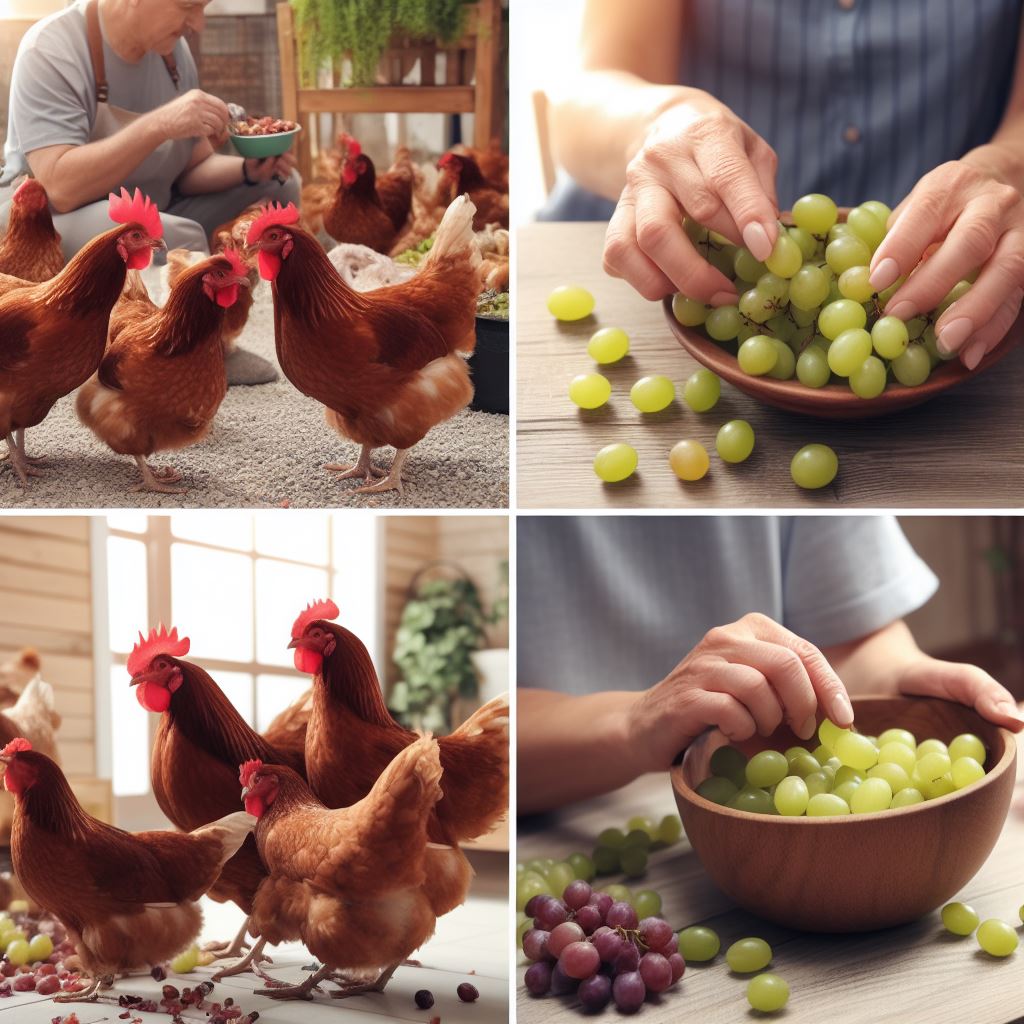 Ideal Serving Methods for Grapes
Ideal Serving Methods for Grapes
Follow these tips for easy, safe methods to serve grapes:
- Wash grapes thoroughly just before feeding. Pat dry if needed.
- Remove stems/vines, then chop into bite-sized pieces.
- Portion into individual servings for each chicken while confined in a pen or coop.
- Alternatively, separate chickens into small groups and provide 2-3 grape pieces per bird.
- Hand-feed pieces directly to each chicken or scatter on the ground.
- Feed other treats like mealworms after grapes to prevent gorging.
- Always monitor chickens while eating grapes in case of choking.
- Limit grape treats to a couple times weekly at most.
Hand-feeding grape pieces allows you to control portions. Scattering treats in multiple areas prevent crowding.
Always supervise chickens when providing any new food like grapes to watch for issues. Remove any uneaten grapes promptly after feeding.
Do’s and Don’ts of Feeding Grapes to Chickens
DO:
- Choose seedless grape varieties
- Chop grapes into small, bite-sized pieces
- Introduce slowly and watch for reactions
- Feed just a few pieces per chicken, 2-3x weekly
- Provide ample fresh water to aid digestion
- Monitor chickens’ weight when feeding treats
DON’T:
- Exceed recommended portion sizes per chicken
- Offer grapes daily or in large amounts
- Feed grapes with other sugary foods
- Allow access to grape leaves or vines
- Store leftover grapes at room temperature
- Feed grapes with visible mold or spoilage
Following these simple guidelines will allow you to provide grapes as an occasional treat, without risking your chickens’ health and wellbeing.
FAQs
Are grapes a choking hazard for chickens?
Grapes can pose a choking risk if fed whole due to their round, supple shape. Always chop grapes into quarters or smaller pieces before feeding to prevent choking. Supervise chickens while eating to monitor for any issues.
Can chickens eat red grapes?
Yes, both red and green grapes are safe for chickens to eat. Neither variety appears to have any toxicity risks for chickens. Red grapes provide antioxidants like resveratrol and vitamin C.
Are grapes high in calcium for chickens?
No, grapes contain minimal amounts of calcium compared to a chicken’s daily requirements. Laying hens especially need extra calcium from sources like oyster shells. Balance out high-sugar treats like grapes with calcium-rich foods.
Can chickens eat grape skins?
Yes, chickens can safely eat the entire grape – skin, seeds, and flesh. However, grape skins have a lower nutritional value than the juicy interior. Still, leaving skins on is fine since chickens typically swallow pieces whole anyway.
Can chickens eat raisins?
Dried grapes like raisins are very high in sugar content. They also lack the water content that helps offset fresh grapes’ sugar. For these reasons, raisins are not recommended for chickens. Stick to fresh grapes only.
Conclusion
Grapes make a yummy, hydrating treat that most chickens enjoy. Just be sure to introduce new foods slowly. Feed no more than a few bite-sized pieces per chicken, 2-3 times weekly. Monitor your flock for any signs of digestive upset or other reactions.
Avoid letting chickens overindulge, as grapes offer minimal nutrition compared to a balanced diet. While grapes provide valuable antioxidants and nutrients, they lack the protein, fat, and calcium essential for long-term health.
Use grapes sparingly as part of a varied diet to keep chickens active and laying healthy eggs. Maintain a healthy flock by feeding a nutritious complete feed, fresh greens, and moderate treats like grapes.
Welcome. I’m Adreena Shanum, the proud owner of this website, and I am incredibly passionate about animals, especially poultry. I founded adreenapets.com as a labor of love, stemming from my desire to share my knowledge and experiences with poultry enthusiasts worldwide.


